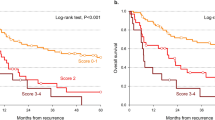Abstract
Evidence suggests wide variation in cancer care between different hospitals in the UK. To establish bench-marking data, we designed a prospective, 1 year regional study comparing key performance measures with established standards for the 28 hospital Trusts in the South and West of England involved in head and neck cancer care. 566 sequential patients with a newly-diagnosed head and neck cancer were included. Numbers referred and treated per hospital Trust were 1–58 and 1–65 respectively. 59% of patients received a pretreatment chest X-ray (standard 95%). 45% of patients were seen in a multidisciplinary clinic pretreatment (standard 95%), and this was proportional to the frequency of clinics held (P< 0.0001). Median number of cases treated per surgeon was 4 (1–26), and by radiotherapist was 10 (1–51). Times between parts of the process of oral cancer care were closer to the standards than those for laryngeal cancer. Two patients were entered into a clinical trial. One had a quality-of-life score. Thus, in 1996–1997, in the South and West of England, there were major discrepancies between actual performance and established standards in many fundamental aspects of head and neck cancer care. Re-audit is essential to determine if the implementation of the Calman–Hine report has resulted in improvements. © 2000 Cancer Research Campaign
Similar content being viewed by others
Article PDF
Change history
16 November 2011
This paper was modified 12 months after initial publication to switch to Creative Commons licence terms, as noted at publication
References
Birchall M (1995) Head and neck cancer services in Avon and Somerset: profile and proposals for development. Report to the regional health authority, University of Bristol: Bristol
Birchall MA (ed) (1997). Consensus standards for the process of head and neck cancer care, South and West Regional Cancer Organisation: Bristol
Birchall MA the South and West Expert Tumour Panel for Head and Neck Cancer (1998) Consensus standards for the process of cancer care: a modified expert panel method applied to head and neck cancer. Br J Cancer 77: 1926–1931
Calman KC and Hine J (1995) A policy framework for commissioning cancer services. A report by the Expert Advisory Group on Cancer to the Chief Medical Officers of England and Wales, Department of Health: London
Department of Health (1996). The protection and use of patient information, Guidance from the Department of Health: London
Dickinson AJ, Howe K, Bedford C, Sanders T, Prentice A and Sibley GNA (1996) A retrospective study of the investigation and management of muscle-invasive bladder cancer in South West Region. Br J Urol 77: 70–75
Dische S, Saunders M, Barrett A, Harvey A, Gibson D and Parmar M (1997) A randomised multicentre trial of CHART versus conventional radiotherapy in head and neck cancer. Radiother Oncol 44: 123–136
Edwards D, Johnson NW, Cooper D and Warnakulasuriya KAAS (1997) Management of cancers of the head and neck in the United Kingdom: questionnaire survey. BMJ 315: 1589
Edwards DM and Johnson NW (1999) Treatment of upper aerodigestive tract cancers in England and its effect on survival. Br J Cancer 81: 323–329
Glaholm J (ed) (1997). Quality assurance in head and neck oncology, British Association of Head and Neck Oncologists: London
Houghton DJ, Hughes ML, Garvey C, Beasley NJ, Hamilton JW, Gerlinger I and Jones AS (1998) Role of chest CT scanning in the management of patients presenting with head and neck cancer. Head Neck 20: 614–618
Jackson S, Murdoch J, Howe K, Bedford C, Sanders T and Prentice A (1997) The management of cervical carcinoma within the South West Region of England. Br J Obstet Gynaecol 104: 140–144
Johnson NW, Giles A (eds)(1999). National minimum and advisory head and neck cancer data sets, British Association of Head and Neck Oncologists & The National Advisory Group on Screening for Oral Cancer: London
Kee F, Wilson RH, Harper C, Patterson CC, McCallion K, Houston RF, Moorehead RJ, Slaon JM and Rowlands BJ (1999) Influence of hospital and clinician workload on survival from colorectal cancer: cohort study. BMJ 318: 1381–1386
Levendag PC, Nowak PJ, van der Sangen MJ, Jansen PP, Eijkenboom WM, Planting AS, Meeuwis CA and van Putten WL (1996) Local tumor control in radiation therapy of cancers in the head and neck. Am J Clin Oncol 19: 469–477
Martin IG, Young S, Sue-Ling H and Johnston D (1997) Delays in the diagnosis of oesophagogastric cancer: a consecutive case series. BMJ 314: 467–470
Richardson A (1998). Finding their voices. The views of persons who have had a laryngectomy on the process of head and neck cancer care, South and West Regional Cancer Organisation: Bristol
Robertson AG, Robertson C, Soutar DS, Burns H, Hole D and McCarron P (1999) Treatment of oral cancer: the need for defined protocols and specialised centres. Presented at the Annual General Meeting of the British Association of Head and Neck Oncologists: London,
Rogers SN, Lowe D, Brown JS and Vaughan ED (1998) A comparison between the University of Washington Head and Neck Disease-Specific measure and the Medical Short Form 36, EORTC QLQ-C33 and EORTC Head and Neck 35. Oral Oncol 34: 361–372
Ryall RD (1992) Medical manpower and workload in clinical oncology in the United Kingdom. Clin Oncol 4: 69–70
Shepherd NA and Quirke PJ (1997) Colorectal cancer reporting: are we failing the patient?. Clin Pathol 50: 266–267
Sikora K (1998) Cancer reforms lag behind. Hospital Doctor September: 42–43
South and West Cancer Intelligence Unit (1996). Factsheet No. 12: Head and neck cancer in the South and West, South and West Cancer Intelligence Unit: Winchester
Stiller CA (1988) Centralisation of treatment and survival rates for cancer. Arch Dis Child 63: 23–30
Tobias JS, Selby PJ, Gupta NK, Rhys-Evans PH, Peto J and Houghton J (1992). UKHAN I, UKCCR Head and Neck Collaborative Group: London
Tobias JS (1997) Management of head and neck cancer in Britain. Plenty of room for improvement. BMJ 315: 1556
Union Internationale Contre le Cancer (1997). TNM atlas, 4th edn, Springer: Berlin 5–63
Wilson GD 1998a) Tpot and head and neck cancer: where are we now?. (1998). Anticancer Res 18: 4801–4805
Wilson J (ed) (1998b). Effective Head and Neck Cancer Management, British Association of Otorhinolaryngologists Head and Neck Surgeons: London 21–22
Wilson J (ed) (1998c). Effective Head and Neck Cancer Management, British Association of Otorhinolaryngologists Head and Neck Surgeons: London 30–34
Wilson J (ed) (2000). Effective Head and Neck Cancer Management, 2nd Edn, British Association of Otorhinolaryngologists Head and Neck Surgeons: London
Author information
Authors and Affiliations
Consortia
Rights and permissions
From twelve months after its original publication, this work is licensed under the Creative Commons Attribution-NonCommercial-Share Alike 3.0 Unported License. To view a copy of this license, visit http://creativecommons.org/licenses/by-nc-sa/3.0/
About this article
Cite this article
Birchall, M., Bailey, D., Lennon, A. et al. Performance and standards for the process of head and neck cancer care: South and West audit of head and neck cancer 1996–1997 (SWAHN I). Br J Cancer 83, 421–425 (2000). https://doi.org/10.1054/bjoc.2000.1302
Received:
Revised:
Accepted:
Published:
Issue date:
DOI: https://doi.org/10.1054/bjoc.2000.1302
Keywords
This article is cited by
-
Effect of process standards on survival of patients with head and neck cancer in the south and west of England
British Journal of Cancer (2004)



